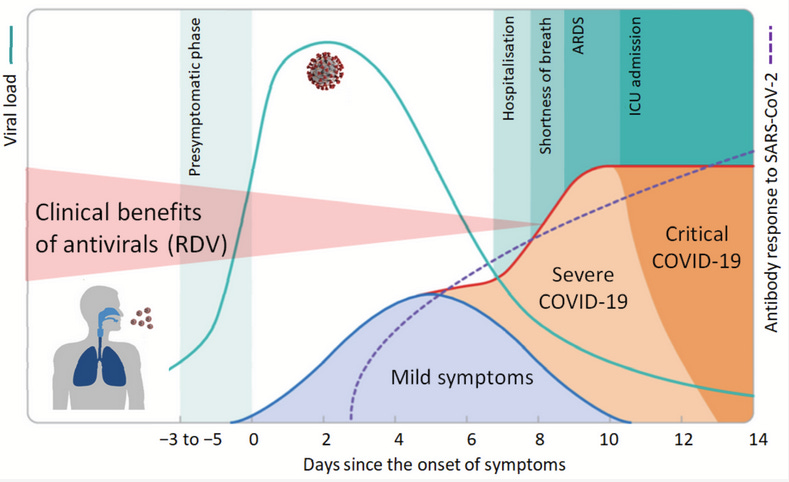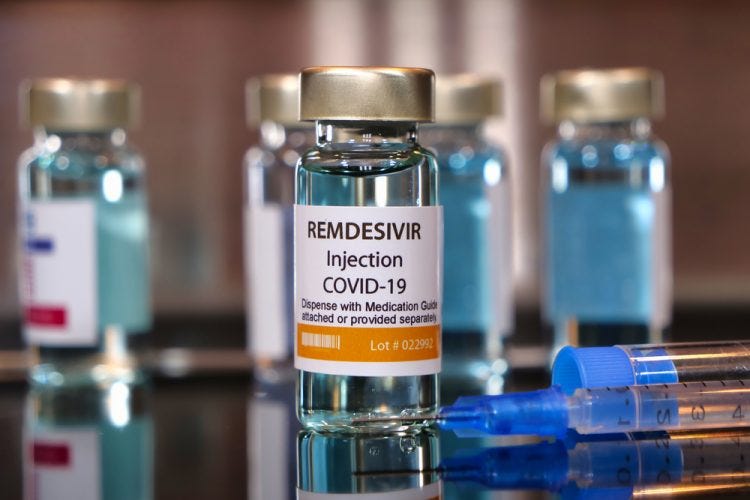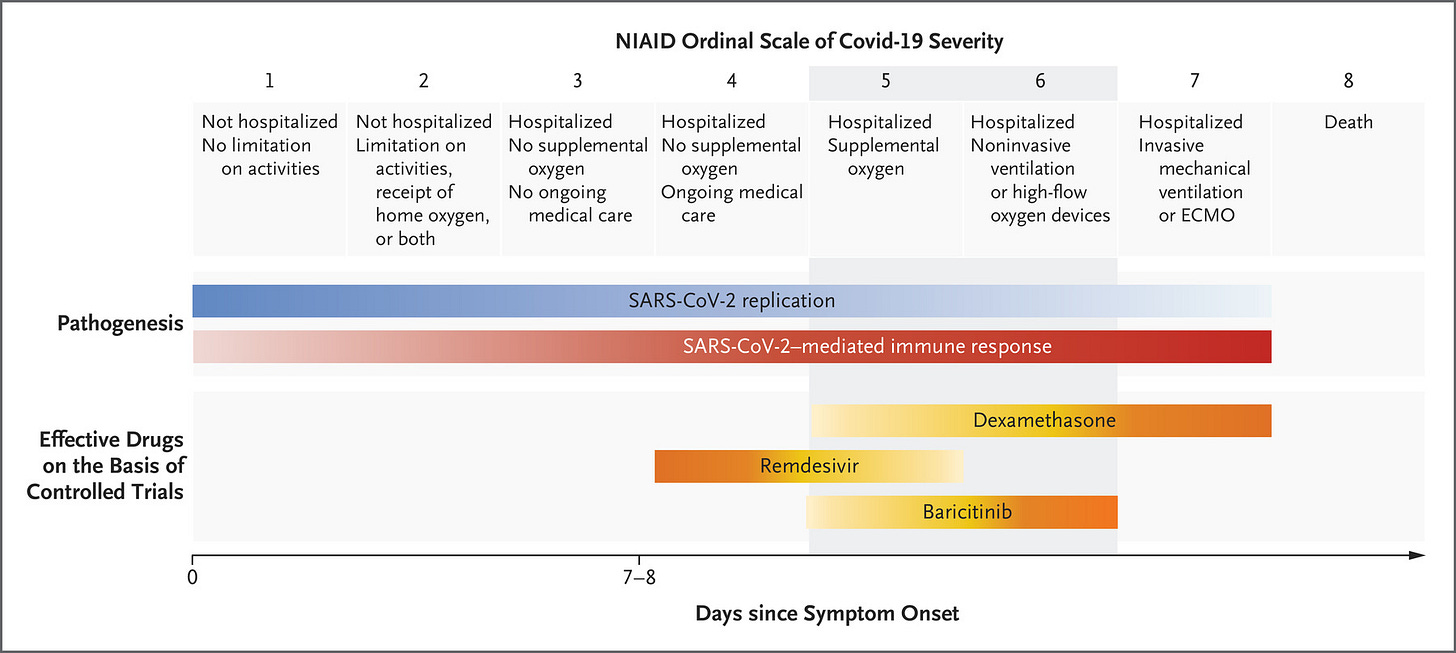The Remdesivir Riddle
The drug was knowingly deployed in a way that prevented it from being effective. Why?
Remdesivir is a broad-spectrum anti-viral that early on in the pandemic was touted as our first victory in the fight against COVID-19. Ever since, however, the drug has remained controversial, and different public health institutions have wildly varying approach to whether, and how, it should be used.
When Should Antivirals Be Administered?
The first thing to know about antivirals in treating COVID-19 is that they are best given early. Both Paxlovid and Molnupiravir insist that treatment should start as soon as possible, and definitely no later than 5 days after onset of symptoms.

However, something strange happened with remdesivir. Until recently, the treatment guidelines insisted that it only be used for severe COVID-19 patients, which in practice meant 7 or 8 days after the onset of symptoms:
In other words, remdesivir is being given *after* the viral replication phase has wound down, at a time where the patient is in a far worse state, and there is little or no help it can provide.
This explains the absolutely terrible reputation the drug has. The WHO recommends against its usage due to bad results in the trials it organized, and overall the evidence of its effectiveness apear to be extremely weak. According to c19rmd.com, among randomized controlled trials, here the sum of the evidence looks like this:
You’d think that Gilead, its manufacturer, would be embarassed to put out such a weak product to market, especially given its constant association with kidney failure in patients that receive it.
You might be surprised to hear that about 20% of Gilead’s 2021 revenue came from sales of remdesivir, which enjoyed USD 5.6 billion in sales. As far as they are concerned, remdesivir is a runaway success.
In fact, the US government goes as far as to pay hospitals to use it, with a bonus in the tens of thousands of dollars per patient that uses it, called the “New Treatments Add-On Payment”. No wonder US hospitals spent over USD 1 billion on remdesivir last year, more than on any other drug.
So we are faced with the riddle of remdesivir: why is a drug that costs more than $2000 per treatment, which is associated with kidney failure, being given at a time that reason, and research, tells us it can’t have much of an effect?
The FDA Knew
The plot thickens, as it turns out the FDA knew the treatment timing made no sense.
The Emergency Use Authorization (EUA) of remdesivir, released via a Freedom of Information Act (FOIA) request contains an incredibly troubling paragraph:
Clinical Virology remains concerned about the disconnect regarding this drugs mechanism of action and the timing of treatment administration. Remdesivir is an analog of adenosine triphosphate that inhibits viral RNA synthesis, and as such, the drug would most likely work early in the infection cycle when SARS-CoV-2 replication is occurring at a high level. Most patients who are hospitalized with COVID-19 are entering the hospital during the second week of infection when viral loads are in decline and the underlying disease is associated with severe lung pathology driven by a hyperactive immune response and cytokine release syndrome. It is not clear that remdesivir will have much of an impact on viral replication this late into the infection cycle.
In other words, exactly what we’ve documented in this article so far.
This paragraph was written on the 4th of May of 2020, only a few months after the official declaration of a pandemic, and almost two years ago. And yet, the vast majority of remdesivir administration was made with this observation being obvious enough that the FDA reviewers could notice it. I refuse to believe that the Gilead staff did not understand enough pharmacology not to make this incredibly obvious error.
People on Twitter Knew
So not only was the drug delivered in a way that could not have much of an effect, this fact was knowable. It was so knowable that a few months later, Twitter user Mia Rosenbloom wrote the following, as a run-of-the-mill complaint about something she saw on MSNBC:

We’re either looking at a pharmacology savant with access to “independent news sources” that are light years ahead of what the scientists at Gilead knew, or this was a deliberate choice.
Trump’s Doctors Knew?
Based on the above observations, in a private conversation I predicted that Donald Trump quite likely was given remdesivir early in the course of his treatment. Indeed it looks that way. It is quite likely that Donald Trump first tested positive on Saturday, September 26, 2020. This must have been at least 3-4 days before symptom onset, because he was able to carry on with a full schedule for the majority of the next week, including a debate with Joe Biden. October 2, six days later, Trump announced by tweet that he was positive. That same evening, his physician put out a statement:
He is not requiring any supplemental oxygen, but in consultation with specialists we have elected to initiate Remdesivir therapy. He has completed his first dose and is resting comfortably.
Hotez Knew
In other words, Donald Trump was treated with remdesivir in the way that reason dictates: as soon as possible. Peter Hotez commented, matter-of-factly:

And yet almost everyone else got the drug when it was already too late for it to help.
In 2022, a Case of Sudden-Onset Reason
And then, on the 21st of January 2022, the following headline hit the internet: “FDA Takes Actions to Expand Use of Treatment for Outpatients with Mild-to-Moderate COVID-19”, barely 10 days before the full approval of the second mRNA vaccine by Moderna.
Indeed, the case for early-stage administration of remdesivir is thin, but a lot more promising. from c19rmd.com:
In fact, Gilead is so excited about the early administration of remdesivir it’s working on an oral formulation:

This is incredibly confusing. It seems that everyone knew the right answer all along, but we kept getting it wrong, for almost two years.
Enter the Wuhan Clan
The story of the approval of remdesivir back in April/May 2020 is a head scratcher, given the evidence we had on hand. Many good pieces tell the story, and “The Strange Story Of Remdesivir, A Covid Drug That Doesn’t Work” is a good summary. However, very little can really convey the weakness of the data than this video of Anthony Fauci himself explaining the basis for the authorization:

As a side note, besides Fauci, a cast of characters well known among those who have been investigating the lab leak hypothesis make their appearance. Peter Daszak was sure to claim credit for assisting in the development of remdesivir:
But the real hero in the development of remdesivir is Mr. Gain-of-function himself, Ralph Baric. What was his role? Allow him to explain:

China Knew?
It should come as no surprise, then, though it undoubtedly will, that on January 21, 2020, the Wuhan Institute of Virology applied for a patent in China on the use of remdesivir for COVID-19.

This happened the day after the WHO admitted that for SARS-CoV-2, human-to-human transmission is real, sending shockwaves around the world. It’s unclear if that patent was enforceable in light of Gilead’s earlier patent, but what is crystal clear is that someone knew exactly what to do, and they showed their hand on the first day that they politically could do so.
What has happened since then? Well, it appears that Chinese scientists, including ones from the Wuhan Institute of Virology, are trialing an oral early-treatment drug called “VV116” which is a modified version of GS-441524, the parent nucleoside of remdesivir, which might actually be more effective than remdesivir itself. GS-441524 is also patented by Gilead, but for whatever reason it has chosen to focus on remdesivir instead.
Victims in a War on Early Treatment?
At this point, one is forced to speculate. The forced early approval, as well as the odd placement of remdesivir on the treatment schedule left a gap in early treatment options that is just now beginning to be filled. Why didn’t Gilead do a study on early treatment earlier?
Monoclonal antibodies were indeed an option that was available, but due to many challenges, some of them administrative, a study found that over a period of 7 months, only 0.3% of eligible patients had received them.
Was there a deliberate decision for the greater good that early treatment must be held back until as many as possible are vaccinated and/or the main vaccines receive full authorization? This will sound conspiratorial, but how else can we explain that remdesivir continues to be provided to this day on highly controversial data, and yet fluvoxamine, an off-patent early treatment drug for which the evidence is mounting, cannot get past “inconclusive”, as far as the NIH is concerned.
This is a story that is just now beginning to unravel, so I’ll turn the investigation over to you: What explains the remdesivir riddle? Let me know your thoughts in the comments below.








Wasn't the chance of the vaccine being approved under FDA Emergency Use Approval (EUA) compromised if there were viable -working- alternate treatments available? Hence Ivermectin, (maybe HCQ too ) ambushed and shot down by vested interests? https://www.fda.gov/media/155863/download
In the terms of the massive research funding budgets that Fauci controls, as Robert F Kennedy Jr described in some detail to Chris Martenson, Fauci arranges royalty patents to his favored insiders. And as you describe, the preeminent insiders Baric and Daszak were involved in this one. Maybe he owed Gilead a piece of the pie too. In this article, Remdesivir was offered on one hand while disgracefully taking away hydroxychloroquine with the other hand:
https://drstevenhatfill.com/open-letter-to-america/